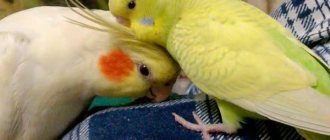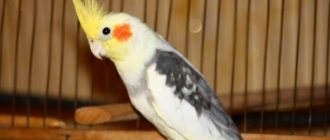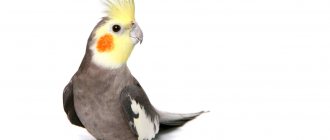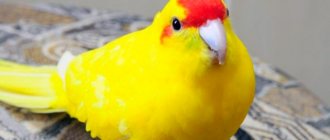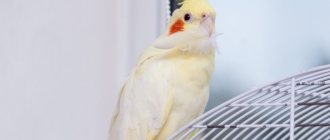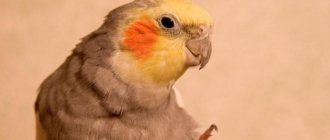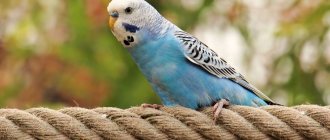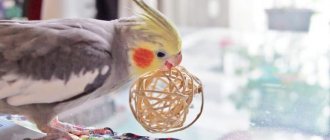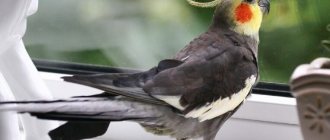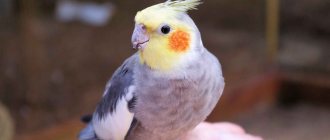Pros and cons of keeping a cockatiel at home
Keeping any pet comes with both pleasant moments and certain difficulties. Let's look at the advantages of keeping parrots of this species:
- Smell . There is no odor coming from the body or feathers, and even a cage that is not cleaned for a couple of days will not cause any trouble.
- Walking . Walking with birds does not force owners to get up early in any weather and leave the house.
- Lifespan . These parrots can live up to 18 years (with proper care).
- Health . Corellas are distinguished by good health, and if you keep your pet according to all the rules, the likelihood of his illness is almost zero.
- Character . Each bird has its own character; the owner will receive great pleasure from communicating and studying its habits.
- Sociability . These birds naturally live in a flock, so in captivity they also need communication. They will try to involve you in all their games and activities. They love to receive and give affection.
- Circus performers . Parrots are easy to train and can learn to perform some tricks.
Did you know? The smallest parrot lives in New Guinea and is only 9 cm tall.
In addition to the positive aspects, there are also disadvantages to keeping this bird:
- Allergy . Parrots secrete a substance that may not be immediately noticeable to the body at first, but over time it accumulates and can lead to a negative reaction.
- Noise . Parrots are very active birds; if they are not screaming (which is how they communicate), then they are busy with something else, for example, playing with bells or running around the cage and throwing up all the objects.
- Dirt . These feathered creatures love to shit everywhere and often, and since they have liquid droppings, it can be anywhere. In addition, they love to throw away all the food that you treat them with.
- Sabotage . Parrots love to taste everything, so they can ruin many household items.
- Diseases . The health of a parrot directly depends on the conditions of detention. If a bird develops even minor symptoms, you need to react immediately so that it is not too late, since only an ornithologist, who cannot be found in all cities, can help you.
- Attention . These birds are very sociable and dependent on the attention of their owner. They will completely capture your attention and will be jealous of other household members. It will not be possible to live your usual life separately from the bird, since the pet may begin to get sick.
- Separation . During a long absence, you will need to find a person who will take the parrot for himself or who will come to visit him every day and play. It is important to understand that separation from the owner for a long time is stressful for the bird.
- Bites . A parrot may bite for many reasons. This must be taken into account when deciding to buy a bird if there is a small child in the house.
It will be useful for you to know: why a parrot screams and why they need sand.
Feeding cockatiel chicks
The parents of the chicks themselves must feed them, but if for some reason this does not happen, they have to take matters into their own hands.
Using ready-made feed to feed chicks is quite simple. Just follow the instructions on the package. At first, cockatiel chicks are fed approximately every one and a half to two hours. Week-old chicks should receive food once every 3-4 hours.
If it is not possible to purchase ready-made mixtures, they are made independently. To do this, you need to mix the following components: grated carrots, apples, wheat crackers, egg, sprouted wheat. All products are crushed to a consistency suitable for feeding.
Growing chicks are offered 1 tsp. freshly prepared mixture. Fish oil is given no more than once a week:
2 tbsp. semolina, 1 tbsp. infant formula, hard-boiled egg - 2 pcs., calcium, glucose - 3 tablets each.
Corn
Milk soft grains are given raw to the bird, and porridge can be cooked from dried corn grains.
How much does it cost and where is the best place to buy?
The advantages of purchasing a bird at a pet store include the opportunity to purchase everything at once (cage, feeders with drinkers, food, toys). However, in stores the parrot completely lacks the ability to fly and it is unlikely that anyone will tell you how much time he spent in the cage. In addition, they may be less sociable and more difficult to make contact because they are not accustomed to communicating with people.
Resellers treat birds as simple goods, so the condition of the bird may not be entirely good. In addition, the birds may be quite old and it is unlikely that you will find out the truth about his age and health.
It will be useful to learn how to properly care for cockatiel chicks.
When buying a bird from a breeder, you need to see how he treats it. With an obvious rude attitude, the cockatiel will be timid and difficult to make contact, since communication with people did not bring her positive emotions. However, if the attitude is good, then purchasing the birds from a breeder is the best idea as they provide the most suitable conditions for them and handle them.
The price for one bird starts from 20 US dollars and increases depending on the pedigree.
Did you know? Parrots give their chicks names, each with a special chirping sound.
Approximate weekly diet for a cockatiel
1 day:
mixture of grains, soft food, sprouted millet, boiled corn.
2:
a mixture of grains with dried nettles, sprouted wheat, oat sprouts.
3:
mixture of grains, crackers soaked in milk.
4:
soft food with a grain mixture, apples, rosehip decoction.
5:
a mixture of grains with herbal flour, nuts, sprouted oats and wheat, grated carrots, rosehip infusion, corn grains or peas.
6:
soft food, a mixture of grains with the addition of grass meal, grated vegetables (for example, beets).
7:
grain mixture, sprouted oats with bananas.
Spring diet
1 day:
mixed grains, soft food, sprouted millet and oats.
2:
mixture of grains, millet sprouts, grated beets.
3:
grain mixture, sprouted wheat, oats and millet, grated carrots with cottage cheese.
4:
grain mixture, soft food, grated vegetables.
5:
a mixture of grains, sprouted oats, rosehip decoction, a loaf of bread soaked in milk or water, boiled corn, chopped nuts.
6:
mixed grains, steamed oats.
7:
mixture of grains, sprouted wheat, citrus slices, rosehip decoction, fresh young greens.
Summer diet
1 day:
a mixture of grains, soaked white bread, cottage cheese, dandelion leaves or other greens.
2:
soft food, grain mixture, greens.
3:
mixed grains, dandelion leaves, cucumber or other vegetables.
4:
mixed grains, fruit slices, herb seeds.
5:
soft food, mixture of grains, crackers soaked in milk, greens.
6:
mixture of grains, grated carrots with nuts, greens.
7:
a mixture of grains, cabbage and lettuce leaves, fresh berries, fruit slices.
Autumn diet
How to choose a parrot when buying
To avoid getting into trouble when choosing a parrot, you need to know what to look for when purchasing.
Appearance
A healthy appearance must meet the following indicators:
- The plumage should be clean, smooth, without noticeable bald patches.
- The eyes are shiny and clear. There should be no redness, swelling or cloudiness.
- The nostrils are clean, without discharge or growths.
- The beak is smooth, without roughness or growths. The feathers near the beak are not stuck together.
- Paws are pink or gray. Each finger should have a claw and no growths.
- Breathing is measured, without whistling or wheezing.
- There should be no droppings on the cloaca.
Important! If the cage in which the parrot is kept contains droppings of yellow, black and red colors, this indicates disease.
Behavior
Like many other species of parrots, the cockatiel has the ability to imitate human speech. If the bird has talent, then it can even be taught simple phrases. However, birds are reluctant to talk.
Among other things, they are very friendly and easily get along with other birds, however, the presence of neighbors does not free the owners from the need for constant communication with the pet.
We recommend reading about how to properly care for your cockatiel parrot.
Age
In order not to be deceived by an unscrupulous seller, you need to know how you can visually determine the age of a bird.
In a young cockatiel:
- the color of the feathers is less bright than that of adults;
- beak – smooth, gray-pink;
- paws – soft pink with soft scales;
- on the crest there is a small number of feathers, but they are perfectly even.
Important! Babies fly poorly, so they are often at the bottom of the cage.
In addition, at this age, their balance has not yet fully formed, so they are unsteady on their paws and seem clumsy.
Appearance, dimensions
Latin name: Nymphicus hollandicus. The dimensions of the cockatiel are body length including the tail 29-33 cm, half of which is the tail. The average weight of an adult is about 100 grams, although both heavier and lighter ones can be found. Natural color - predominantly gray plumage, yellow face, orange cheeks, yellow-gray crest. In addition to the described color, breeders have developed many other variations. The colors of cockatiels are: regular (or natural), lutino, pearl, albino with red or black eyes, pearl lutino, light gray, cinnamon, motley, white-headed, dark yellow and other variations.
Three ways to determine the sex of a cockatiel. One of the ways is in a squeaking pose: males slightly spread their feathers, their tail is horizontal to the body, and their head is directed downward, while females raise their tail a little up and, unlike males, do not lower their head down, but, on the contrary, throw it on their back. The second is that in males of natural color, as they grow older, the face begins to turn yellow (in the female, the face remains pale gray with a yellow tint, like in chicks), and the color of males is more juicy. For other colors, this method (determination by yellow face) cannot be used. The third way to determine sex is DNA analysis.
The average lifespan of cockatiels is about 15 years. There are also long-livers. For example, the International Zoo Yearbook provides information about an individual who lived 35 years.
List of prohibited foods
In caring for Corella parrots, there is such a thing as forbidden foods. If you feed a bird with just anything, complications with its gastrointestinal tract cannot be avoided. To prevent your cockatiel from having similar problems, he should not be given the following:
- fruits: avocado, mango, persimmon, papaya;
- potatoes;
- onion garlic;
- spices;
- dairy products: cheese, cream, milk;
- drinks: alcohol, coffee, cocoa, tea;
- chocolate;
- foods from your table: fried, fatty, salty, sweet, pickled, sausages, meat, fish;
- mushrooms.
To choose a high-quality grain mixture, you need to buy brands from trusted manufacturers. For example, Fiory (Italy), Prestige (Belgium), Rio (Russia). Always check the composition and expiration date of the food written on the box. You should not buy grain mixture by weight - such food may be expired and contain mold or waste products of various insects. The best option is a sealed package of food that allows you to see the contents.
Communication with a parrot
Corellas are vulnerable and sensitive birds. Especially the females. Therefore, you should adhere to certain rules of communication with them:
- Adaptation. The parrot needs to get used to you and the new place. Usually adaptation takes 1 - 3 days. At this time, it is better not to touch him, talk calmly. You can even sing, so he will get used to you faster.
- Attention. Communicate with the bird as often as possible. Let him out of the cage, sit him on your hand, play. Cockatiels like to be stroked on the head in the direction of their hair growth. At first the parrot may not be able to handle it, but gradually it will become tame and get used to it.
- Accuracy. Corellas are sensitive birds. An awkward movement can lead to injury. Therefore, it is not recommended to have a parrot in a family with children under 3 years of age.
- Aggression. If the bird begins to bite, do not scold it. Understand the reason: insufficient care, uncomfortable conditions, little communication. Cockatiels don't bite for no reason.
Be patient and caring. Especially when learning to speak. Repeat the words one at a time. This way the parrot will learn the word by ear, react to it, and later pronounce it. You shouldn’t give out whole phrases at once. This will cause the bird to become confused and training may take longer.
